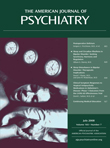Depressive State- and Disease-Related Alterations in Neural Responses to Affective and Executive Challenges in Geriatric Depression
Abstract
Objective: Geriatric depression has been associated with a heterogeneous neuropathology. Identifying both depressive state-related and disease-related alterations in brain regions associated with emotion and cognitive function could provide useful diagnostic information in geriatric depression. Method: Twelve late-onset acutely depressed patients, 15 patients fully remitted from major depression, and 20 healthy comparison subjects underwent event-related functional MRI. Brain activation and deactivation associated with executive and emotional processing were investigated using an emotional oddball task in which circles were presented infrequently as attentional targets and sad and neutral pictures as novel distractors. Results: Significant changes in brain activation in patients were found mainly in response to attentional targets rather than to sad distractors. Relative to healthy comparison subjects, the depressed patients had attenuated activation in the regions of the executive system, including the right middle frontal gyrus, the cingulate, and inferior parietal areas. Activity in the middle frontal gyrus revealed depressive state-dependent modulation, whereas attenuated activation in the anterior portion of the posterior cingulate and inferior parietal regions persisted in the remitted subjects, suggesting a disease-related alteration. Enhanced deactivation was observed in the posterior portion of the posterior cingulate, which was also state dependent. The remitted group did not show this deactivation. Conclusions: Our results indicate distinct roles for the right middle frontal gyrus and the anterior and posterior portions of the posterior cingulate cortex in geriatric depression. The deactivation of the posterior portion of the posterior cingulate could be informative for differentiation of cognitive dysfunction related to depression from other conditions, such as mild cognitive impairment.



